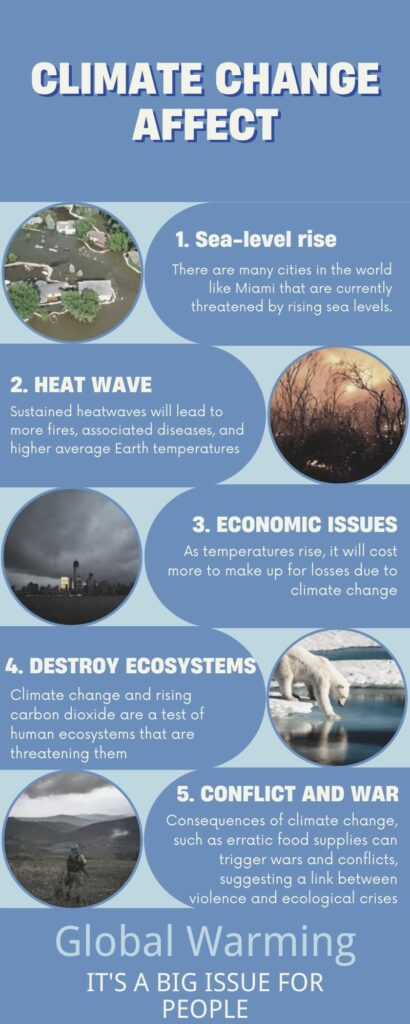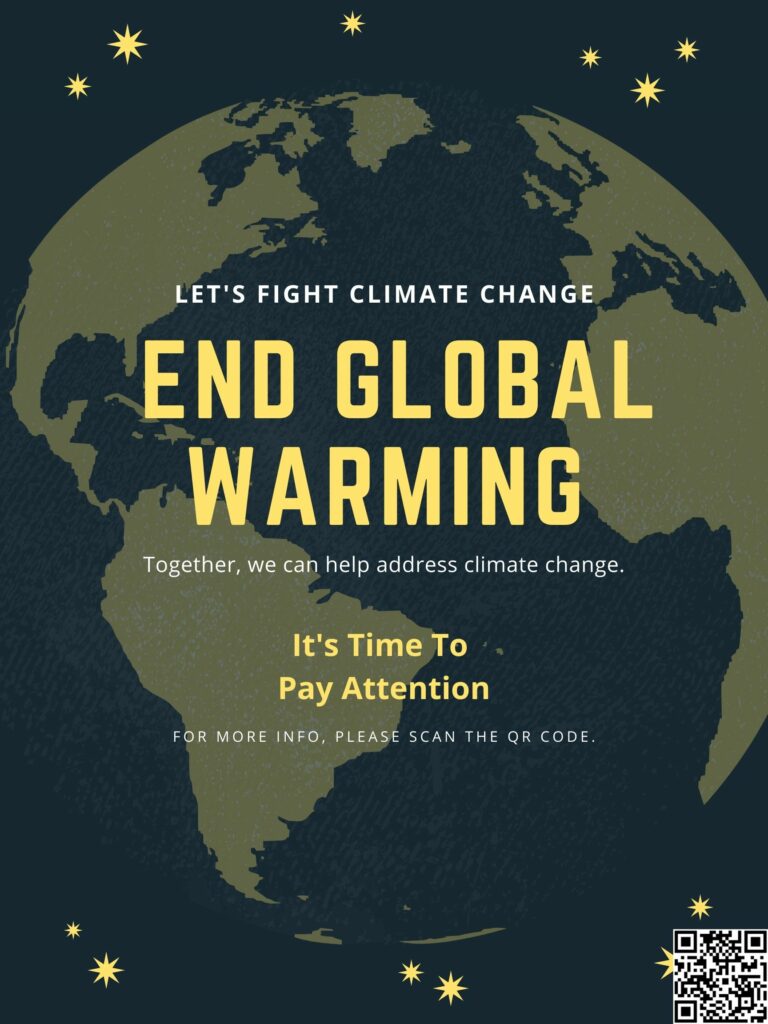Introduction to the Climate Change
Group member: Hengyu Qi, Mengcheng Liu
Learning Outcomes:
By end of this blog, learners should be able to know:
1. What is climate change
2. What causes climate change
3. How does climate change affects people
4. How to improve the environment
Introduction:
Climate change is a difficult problem. The biggest issue of climate change is the environmental impact of humans, especially global warming. Global warming is destroying ecosystems. In this blog we will talk about climate change and how to improve the environment.
Climate change & cause:
Climate change refers to long-term shifts in temperatures and weather patterns (United Nations, nd). It is usually reflected by differences in the statistics of climate elements such as temperature and precipitation in different periods. The length of the variation ranges from the longest to the shortest interannual variation.
The earth has an extremely complex climate system. Climate change can be divided into 2 categories: natural climate fluctuations and human activities. Natural climate fluctuations includes changes in solar radiation and volcanic eruptions. Human activities include increases in burning of fossil fuels and deforestation, changes in sulfide aerosol concentrations, and changes in land cover and land use.
We made a PPT and showed it to everyone in a video. In this video we mainly introduce 5 causes to the climate change.
The original PPT(video) at below:
Affects (people):
Climate change is a serious issue. “Global warming could lead to volatile weather, heat waves, heavy precipitation, flooding, droughts, intense storms, and sea-level rise“(WHO). Climate change will affect People’s Daily living environment and people’s health. Climate change can lead to extreme weather. These extreme weather often threaten the safety of our lives and property. For example, earthquakes can destroy houses and kill people. In addition, climate change will cause the spread of many diseases. Global warming, a long-term climate change, has led to the activation of many diseases. At the same time, climate change will also impair human immunity and susceptibility to disease, thereby affecting the spread of disease. It could lead to ecosystem degradation and put pressure on agriculture, reducing crop yields.
We made an infographic about the climate change affects people, and summarized 5 affects.
The original Infographic at below:

How to Improve:
It takes a lot of effort to ameliorate the climate. For example, if we want to stop the global warming, we first need to replace fossil fuels with renewable energy. Of course, this is a problem that requires the joint efforts of all mankind. So what can we do in our daily lives to help stop global warming? We can drive less and fly less. We can change our eating habits. Raising cattle and sheep will emit a large amount of carbon dioxide, which leads to global warming. Reducing the consumption of meat can effectively help slow down global warming. And we can change the frequency of shopping, nowadays more and more people like to buy a lot of clothes and most of them only wear a few times and then go unused. The process of making clothing also produces a lot of carbon that worsens our environment. In addition to global warming, there are many negative climate changes, such as acid rain and sand storms. These also need us to work together to improve. Growing plants is an urgent matter. It will help us absorb carbon dioxide, stabilize the soil, and clean up the air. Improving the environment is an issue that we should pay attention to now. I hope we can work together.
In the end, we made a poster to conclude and appeal to everyone who watches our blog: it is everyone’s responsibility to care for the environment.
The original Poster at below:

Learning Activity:
1.After reading this blog, students need to reflect on climate change and leave a comment below the blog.
2. After reading this blog, if you don’t understand the content, please leave a comment below the blog.
3. If possible, students should review more resources on climate change (videos, articles, blogs, etc.)
Learning design & theory:
Through the study of multimedia technology in this semester, we chose the method of poster making, presentation making and infographic making to share our research on climate. First, we used the Segmenting Principle to divide our learning objectives into four parts. This makes our learning objectives clearer and we think students will not have any barriers. After this semester’s study, we discovered a new theory – Cognitive Load. It illustrates that people are limited in what they can touch and remember in a short period of time, so they should omit the tedious text description. So, in our PPT, we focus on the cognitive load that we’ve learned in class. We only mention one point per slide and explain it with some short text. At the same time, we add background music to the presentation to make it softer to make it more interesting. Then we included an infographic in the blog so that they could intuitively feel the changes in the data. We added a QR code to the poster to keep it informative. In order to keep the volume of text as low as possible, we included only a few keywords in the posters and powerpoint to ensure that viewers could quickly understand the topic. This is consistent with Signal theory in the course. In our blog, we also apply Cognitivism. It focuses on a learner’s mental processes, such as thinking, memory, knowing, and problem-solving. In the blog, we use it to stimulate students’ thinking and let everyone protect our planet.
Bibliography:
United Nations. (n.d.). What is climate change? United Nations. Retrieved from https://www.un.org/en/climatechange/what-is-climate-change
Environmental Protection Agency. (n.d.). Causes of Climate Change. Retrieved from https://www.epa.gov/climatechange-science/causes-climate-change
Wu, X., Lu, Y., Zhou, S., Chen, L., & Xu, B. (2015, October 18). Impact of climate change on human infectious diseases: Empirical evidence and human adaptation. Environment International. Retrieved from https://www.sciencedirect.com/science/article/pii/S0160412015300489
Center for Climate and Energy Solutions. (2022, May 18). Extreme weather and climate change. Retrieved from https://www.c2es.org/content/extreme-weather-and-climate-change/
Student Energy. (n.d.). Energy system map. Student Energy. Retrieved from https://studentenergy.org/map/?gclid=CjwKCAjw-8qVBhANEiwAfjXLrpXGsJ-_GD2eJReiSfUkUA9KTRlXCM4Uipy9KhSm4QUMZWlmCZiY6BoCapoQAvD_BwE
National Environment Agency. (n.d.). The National Environment Agency. National Environment Agency. (n.d.). Retrieved from https://www.nea.gov.sg/
National Oceanic and Atmospheric Administration. (n.d.). Climate change impacts. Retrieved from https://www.noaa.gov/education/resource-collections/climate/climate-change-impacts